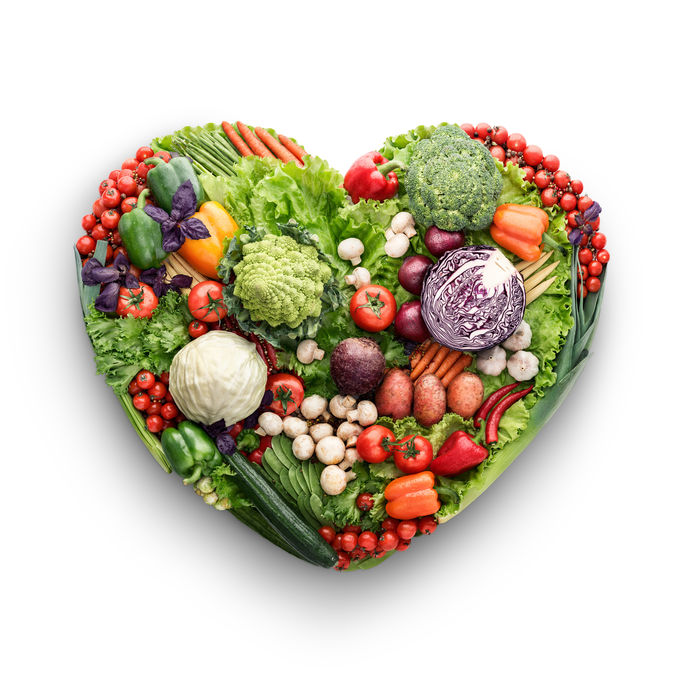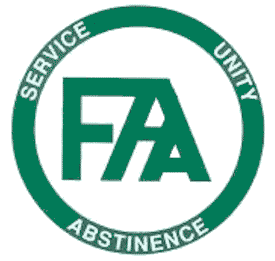Tools of Recovery
If you have decided you might be a food addict, you will need some tools of recovery in order to begin to recover from this disease.
Although we have specific tools, the real strength of the program lies in the members themselves. It is through our membership, with all its wisdom and strength, that recovery occurs. Please join us in our meetings.

Abstinence
FAA believes that food addiction is a biochemical disease that cannot be controlled by willpower, but can be alleviated by avoiding foods that contain sugar, flour or wheat, and working the 12 Steps of the program. We call this “abstinence.”
Definition of Abstinence
Our official definition of abstinence is as follows:
“We ask for help from our Higher Power to abstain from those substances we find ourselves craving, ever mindful of our addiction to sugar, flour, and wheat. Feeding our bodies with a plan of sound nutrition will allow us freedom from the insanity of this disease. With honesty, an open mind, and a willingness to share our experience, strength and hope, we can recover from this disease — ONE DAY AT A TIME.”
To a newcomer, this may seem like an impossible task. But with the support of the membership and by working the 12 Steps of the program, we have found recovery. Many of us have found our lives positively changed in ways that we could not have imagined.

Food Plan
We offer this food plan as a guide to suffering food addicts. It is not meant as a diet, but a lifestyle change in our eating habits. Those of us who have experienced recovery through this program know that this plan only works with the support of our membership and by following the FAA Steps to Recovery. You are not alone. Please seek us out and learn about our fellowship.
Recovering together one day at a time from the biochemical disease of food addiction.
FAA Food Plan Guide
FAA Food Plan Guide
Breakfast
1 Protein
1 Dairy
1 Fruit
1 Grain or Starchy Vegetable
Lunch
4 hours after breakfast
1 Protein
1 Cooked Vegetable
1 Fresh Vegetable
1/2 Daily Oil
Men: Add 1 fruit or 1 grain or 1 starchy vegetable
Dinner
5 hours after lunch
1 Protein
1 Cooked Vegetable
1 Fresh Vegetable
1 Grain or Starchy Vegetable
1/2 Daily Oil
Metabolic Adjustment (MA)
4 hours after dinner
1 Dairy OR 2 oz. Protein
1 Fruit
Names of Sugar
Ace K (Acesulfame-k (Sunette, Sweet and Safe, Sweet One)
Agave
Alcohol Sugars (“ol” endings, i.e., sorbitol, mannitol, etc.)
Amazake
Apple Sugar
Artificial Sweetener Packets
Artificial Flavors (call the company about the product contents)
Aspartame/NutraSweet
Aguamiel
Barbados Sugar
Bark Sugar (also called Xylose)
Barley Malt
Barley Syrup
Beet Sugar
Black Strap Molasses
Brown Rice Syrup
Brown Sugar
Brown Sugar Syrup
Cane Juice
Cane Sugar
Caramel Coloring
Caramelized Sugar
Carob Chips/Powder
Cocoa
Concentrated Fruit Juice
Corn Sweetener
Dark Brown Sugar
Date Sugar
Dextrin
Dextrose
Diglycerides
Disaccharides
Dried/Dehydrated Fruit (i.e. figs, raisins, apple chips, etc.)
Evaporated Cane Juice
Extracts (any type or flavor)
Fat substitutes (made from concentrated fruit paste)
Florida Crystals (evaporated cane juice)
Fructooligosaccharides (FOS)
Fructose
Fruit Flavorings (call the company about the product contents)
Fruit Juice (call the company for added or hidden sugar)
Fruit Juice Concentrate
Galactose (Gal)
Glucitol (Sorbitol or Hexitol)
Glucosamine
Glucose
Glucose Polymers
Glucose Syrup
Glycerides
Glycerine (Glycerol)
Glycine
Glycol
High Fructose Corn Syrup
Honey (any type or form)
Inulin
Isomalt
-ides, any additive with this suffix:
Monosodium glycerides (any), olyglycerides, saccharides (any), trisaccharides, diglycerides, disaccharides, monoglycerides, monosaccharides, etc.
Jaggery
Lactose
Levulose
Licorice root powder
Light Brown Sugar
“Light” Sugar
“Lite Sugar”
“Low Sugar”
Malted Barley
Maltitol
Maltodextrin
Maltodextrose
Maltose
Malts (any)
Mannitol
Mannose
Maple Sugar
Maple Syrup
Microcrystalline Cellulose
Milled Sugar
Modified Food Starch
Molasses
Monoglycerides
Monosaccharides
Monosodium Glycerides
“Natural” Flavors (call the company for product contents)
Natural Milled Cane Sugar
“Natural” Sugar (call the company for product contents)
“Natural” Sweeteners
“Naturally” Sweetened
Nectar(s)
Neotame (Newtame)
-ol, any additive with this suffix:
Carbitol, glucitol, glycerol, glycol, hexitol, inversol, malitol, mannitol, sorbitol, xylitol, etc.
Olestra (made from sucrose)
“OSE” (any, i.e. sucrose, dextrose, fructose, etc.)
Papain
Pectin
Pentose
Polydextrose
Polyglycerides (Also known as Oleic, Linoleic, and Linolenic)
Polytose
Powdered Sugar
Raisin Juice
Raisin Paste
Raisin Syrup
Raw Sugar
Ribose
Rice Malt
Rice Sugar
Rice Syrup (Yinnie Syrup)
Rice Syrup Solids
Saccharides (any)
Sorbitol (Hexitol, Glucitol)
Sorghum (Sorghum syrup, Sorghum Molasses)
Stevia
Sucanat (evaporated cane juice)
Sucralose
Sucrose
Sugarcane
Sugar Cubes
“Sugar Free” Products
Syrups (any)
Salt (read the label for added dextrose)
Table Sugar
Tagatose (D-tagatose)
Trehalose
Trisaccharide
Turbinado Sugar
Unrefined Sugar
Vanillin/Vanilla
Whey
White Sugar
Xanthan Gum
Xylitol
Xylose
NOTE: ALL artificial sweeteners are consider sugar in FAA.
Protein
NOTE: Men eat 5 oz. of red meat and 6 oz. of fish or poultry.
4 oz. beef
4 oz. chicken
1 cup dried beans (cooked)
2 eggs (medium)
4 oz. fish
4 oz. hot dogs (not sugar cured)
4 oz. lamb
4 oz. pork
4 oz. shellfish
4 oz. turkey
4 oz. veal
6 oz. vegetarian (tofu, tempeh)
Vegetables
1 cup of any of the following:
artichoke
asparagus
bamboo shoots
beans (yellow or green)
bok choy
beets
broccoli
brussel sprouts
cabbage
carrots
cauliflower
celery
chicory
chinese cabbage
cucumber
dill pickles
eggplant
endive
escarole
greens *
mushroom
okra
onions
peppers
pimentos
radishes
rhubarb
romaine
rutabaga
sauerkraut
snow pea pods
spinach
summer squash
swiss chard
tomatoes
turnips
vegetable juice
water cress
*beet, collard, danelion, kale, all types of lettuce, mustard, any sprouts (no wheat grass)
NOTE: Tomato juice or vegetable cocktail juice without sugar may be used as a cooked vegetable substitute. 1 cup juice =1 cup cooked vegetables.
Condiments
Any spice or sauce that is sugar-free, alcohol-free or wheat-free including, but not limited to, mustard, tamari, salsa, non-fat yogurt, lemon juice, etc. Limit spice and condiment use to the levels recommended in recipes or no more than 1 teaspoon per day of any one spice and no more than two tablespoons per day of any one sauce.
Dairy
Dairy may also be used as a protein
1 cup buttermilk
½ cup low-fat or non-fat ricotta cheese
1 cup milk (skim or 1% )
½ cup low fat cottage cheese
1 cup low or non-fat yogurt
1 cup unsweetened soy beverage
NOTE: If you are dairy sensitive, eliminate dairy and substitute 2 oz. of any type of protein.
Fats
Polyunsaturated oils are essential to good health. The fat requirement is normally divided between two or more meals.
Women require one fat serving per day and men require two.
Choose from the following:
oil → 1 tablespoon
margarine → 1 tablespoon
mayonnaise → 1 tablespoon
salad dressing → 2 tablespoons
Fruits
1 medium apple
½ cup apple juice
½ cup applesauce
3 medium apricots
1 cup berries
1 cup citrus juice
½ cantaloupe (6″ dia)
1 cup cherries
1 cup cranberry juice
1 cup fruit cocktail
½ large grapefruit
1 cup grapes
¼ honeydew (7″ dia.)
3 small Kiwi
2 small OR 1 large lemons/limes
2 small OR 1 large nectarines
1 large orange
1 large peach
1 large pear
1 cup pineapple
½ cup pineapple juice
3 medium plums
½ cup prune juice
2 small tangerines
1 cup watermelon
Grains
1 cup of any of the following, measured after cooking:
amaranth
barley
brown rice
buckwheat (kasha is toast)
cream of rye
grits
millet
oat bran (1/2 c. raw = 1 cup cooked)
oatmeal
quinoa
rye
1 cup of any non-wheat, sugar-free, dry cereal such as:
puffed brown rice
puffed corn
puffed millet
3 rice cakes = 1 serving
Starchy Vegetables
1 small baked potato (6 oz./white)
½ cup cooked beans (lima, navy, all dried beans)
1 medium corn
½ cup cooked corn (kernel)
½ cup mashed potatoes (white)
½ cup mashed yams
½ cup parsnips
½ cup peas, dried
½ cup peas, green
½ cup pumpkin
1 small sweet potato (6 oz.)
½ cup squash*
*acorn, butternut, hubbard, winter and spaghetti squash
Beverages
Suggested drinks are water, carbonated water, herbal tea, decaffeinated coffee or decaffeinated tea.
Clear soup (without sugar) is permitted before lunch or dinner.
Tomato juice or vegetable cocktail juice without sugar may be used as a cooked vegetable substitute.
1 cup juice = 1 cup cooked vegetables.
PLEASE NOTE:
All diet sodas have artificial sweeteners, which are now known to create cravings similar to sugar.
Names of Flour & Wheat
Types & Forms of Flour:
Agar
Almond flour
Amaranth flour
Arrowroot
Baking flour
Baking powder
Barley flour
Bean flour
Blue corn flour
Buckwheat flour
Chestnut flour
Chia seeds
Chickpea/Garbanzo bean/
Bean flour
Coconut flour
Corn flour
Corn meal
Corn starch
Cottonseed flour
Cream of Tartar
Emmer flour
Enriched bleached flour
Enriched wheat flour
Gelatin
Hemp flour
Kuzu root
Lupin flour
Malted barley flour
Millet flour
Multi-grain flour
Nut flour (any type of nut)
Oat flour
Pastry flour
Pea flour
Potato flour
Potato starch
Psyllium husk powder
Quinoa flour
Rice flour
Rye flour
Sago flour
Soy flour
Sorghum flour
Spelt flour
Spinach flour
Tapioca flour
Teff flour
Triticale flour
Wheat flour
White flour
Yam flour
*Any bean, vegetable, or grain that is ground into flour, meal, or powder is “flour,” as the term is used in the FAA definition of abstinence. Starches and guar gum are also considered flour.
Types & Forms of Wheat:
Bran (if made from wheat)
Bulgur
Cracked wheat
Durum wheat
Einkorn
Emmer wheat
Farro
Gluten (wheat protein)
Hard wheat
Kamut/Khorasan
Red wheat
Red spring wheat
Seitan (made from wheat protein, gluten)
Semolina
Soft Wheat
Spelt
Sprouted Wheat
Triticale (a wheat/rye hybrid)
Wheat berries
Wheat bran
Wheat flakes
Wheat germ
Whole-grain wheat
Winter wheat
PLEASE NOTE:
These lists are not exhaustive. If you are unsure about an ingredient, it is best to check with the manufacturer or forego the product.
** The FAA Basic Food Plan is a guide with specific foods listed. REMEMBER: NO sugar, flour or wheat. **
The daily requirement for oil is one serving for women and two servings for men, to be divided among two or three meals.
NOTE: Men need to add two ounces of fish or poultry or one ounce of red meat at each meal to the amounts shown on the list. At lunch, men also add a serving of one of the following: a fruit, a grain, or a starchy vegetable.
This food plan is designed for adults. For children who need to address food addiction, we recommend that your pediatrician evaluate this food plan to determine your child’s needs.
Clear soup is permitted before lunch OR dinner.
Because of our carbohydrate sensitivity, we totally eliminate all artificial sweeteners, including “sugar-free” sodas.
This initial food plan has been the most successful for our members to obtain abstinence, enabling them to begin to have clear thinking. Eating the prescribed food plan also offers us a chance to heal our organs and learn the basic fundamentals of healthy eating. To maintain abstinence, an open mind will be required while our bodies heal and our needs change. The most important aspect of maintaining abstinence is to totally eliminate sugar, flour and wheat from our daily lives.
The food plan is a way of eating that is free from eating sugar, flour and wheat. The food plan eliminates the basic components of our binge foods: sugar, flour, wheat and inordinate amounts of fat (sticky, greasy, pasty foods). This is not a reducing diet because it is not severely restricted in terms of basic food groups. However, it does reduce fat intake to an appropriate level.
Most food addicts do achieve and maintain a healthy weight by following this plan. Nonetheless, we would like to address the question of what to do when a person following the food plan continues to lose weight after reaching a healthy weight or when a person who is underweight when they begin the program fails to gain. This guide is intended to focus on recovery for food addicts as a whole rather than to address specific situations that arise in recovery. Although unusual, if weight loss or failure to gain continues over time to an inappropriate level, any changes needed to stabilize one’s weight should be developed with the assistance of a sponsor, physician or other qualified professional. The most important thing is to maintain close contact with one’s sponsor and remain totally honest about what we are eating, how much we weigh, how our bodies are functioning, and how we are feeling physically.
GUIDELINES FOR MEAL PLAN
Abstinence is a Commitment to Recovery
Definition of Abstinence: We ask for help from our Higher Power to abstain from those substances we find ourselves craving, ever mindful of our addiction to sugar, flour and wheat. Feeding our bodies with a plan of sound nutrition will allow us freedom from the insanity of this disease. With honesty, an open mind, and willingness to share our experience, strength and hope, we can recover from this disease — ONE DAY AT A TIME.
Of course, to the new recovering person, this appear as another diet. But we who walk this path of recovery know that this program of eating is unique.
One of the obstacles you may encounter in early recovery is the temptation to alter the food plan to suit yourself. It is our experience that deviations recreate our old food problems. To guard yourself against the tendency to rationalize, it is suggest that you discuss any additions or subtractions you may think are necessary with a sponsor or someone in the program who is abstinent.
- Weigh or measure all food as specified. Volume can trigger the disease. Eating larger of smaller quantities of food than recommended on the food plan can cause the physical craving to reappear and can lead us back into the disease of food addiction. Eating added volume or restricting is often the beginning of the relapse process. Invest in measuring cups, measuring spoons, and a good scale. Since this is NOT a diet, wide variety and attractive presentation of your meals will help you stay abstinent. Make it interesting!
- Look for hidden or additional names of sugar, flour and wheat in the “Ingredient” section for the label on all packaged or canned foods, drinks marinades, dressings, and spices, including salt. Do not confuse this with the “Nutrition Facts” section, which may list naturally occurring sugar. For example, the label on a can of tomato paste may list tomatoes as the only ingredient and yet under the “Nutrition Facts” section it may list 3 grams of sugar. The 3 grams of sugar naturally occur in the tomatoes. Check all labels regularly as manufacturers often alter ingredients.
- Low calorie, lite, light, sugarless or sugar-free on a product label does not imply that the manufacturer has not added sugar in one of its many other forms. It is absolutely necessary to read all labels.
- Fresh is best. If fresh fruit is not available, use frozen fruit or canned fruit packed in water or in its own juice. If juice is used, include it as part of the measurement.
- Never use cornstarch or other thickeners.
- This meal plan may help alleviate elevated triglycerides and elevated cholesterol levels caused by excessive carbohydrates and fats. For those with elevated cholesterol levels, limit eggs and red meats to three times a week.
- Red meat should be limited to three to five times per week. Other sources of protein include tofu, tempeh, beans, chicken, fish, low-fat ricotta and low-fat cottage cheese.
- If constipation is a problem, eight 8-oz. glasses of water per day added to your meal plan will help. Exercise, even walking, will also help. Two teaspoons of ground flaxseed on your cereal is also useful.
- Tomato juice or vegetable cocktail juice without sugar may be used as a cooked vegetable substitute.
1 cup juice =1 cup cooked vegetables. - Caffeine is an addictive stimulant and should be avoided. Suggested drinks are decaffeinated coffee, decaffeinated tea, herbal tea, carbonated water, and water.
- Two or more proteins may be combined to equal one protein serving. For example, two ounces of cooked ground meat and one-half cup of pinto beans equals four ounces of protein.
- For abstainers with high blood pressure who are prescribed a low sodium diet, fresh is best, frozen is the next best. Always read the label for sodium content as well as sugar. “Instant” anything has higher sodium content.
- You may use part of you milk allowance as a coffee lightener. One percent or skim milk may be used in this plan.
ROTATE ALL FOODS.
WEIGH AND MEASURE ALL FOODS.
WRITE, COMMIT, AND FOLLOW YOUR PLAN AS SPECIFIED.
WHEN IN DOUBT, LEAVE IT OUT.
PRIOR PLANNING PREVENTS POOR PERFORMANCE
IF YOU FAIL TO PLAN, THEN YOU HAVE PLANNED TO FAIL.
SUGGESTIONS FOR IMPLEMENTING ABSTINENCE
- Following the FAA food plan as written will allow you to become well physically, mentally, and spiritually. The FAA food plan balances proteins and carbohydrates to support steady, stable blood sugar levels and a steady metabolism – essential to prevent triggering cravings and binges. The recommended time between meals further supports this. DO NOT SKIP MEALS!
This schedule works best:
Breakfast + 4 hours = Lunch + 5 Hours = Dinner + 4 hours = Metabolic Adjustment - Active participation in the fellowship through service is one of the best ways to help keep your commitment to recovery.
- Have your doctor review this program of eating and follow his/her suggestions.
- Your food should be written down. By writing your menu for a week, shopping is easier. Planning helps eliminate chaos and last minute choices made when hungry. Going over your meal plan with your sponsor daily will help you feel comfortable at planning nutritious and interesting meals and will affirm your commitment to remain abstinent. A daily log of everything you eat is an additional reinforcement.
- DO NOT WEIGH YOURSELF more than once a month. If you are over or under your ideal weight, you may expect to lose or gain weight on this plan safely and appropriately.
- If something listed on this food program is or becomes a problem for you, eliminate it.
- SIT DOWN FOR MEALS AND EAT SLOWLY.
- Include fish or poultry in your food plan daily if possible.
- We suggest one vegetarian day per week. Try soy protein (tofu or tempeh). Check meat substitutes for wheat.
- Beware of products advertised as low-calorie, low-fat, or fat-free. They frequently contain sugar or flour in some form.
- When eating in a restaurant, ask questions. It’s OK to ask for what you need!
- We suggest taking a multi-vitamin daily. Check vitamins for sugar, flour, and wheat. Ask the doctor or pharmacist to recommend medications that are free of sugar, alcohol, flour, and wheat whenever possible.
- Do not repeat the use of any starchy vegetable or grain more than THREE times per week. We can become sensitive with overuse.
- The food plan is a way of eating that is free of sugar, wheat, and flour. The food plan eliminates the basic components of our binge foods: sugar, flour, wheat and inordinate amounts of fat (sticky, greasy, pasty foods). This is not a reducing diet because it is not severely restricted in terms of basic food groups. However, it does reduce fat intake to an appropriate level.
“For today, I am grateful for the freedom I received with the gift of abstinence.”
Food for the Soul—Page 133
FAA’s Twelve Steps
We suggest working through the 12 Steps using The FAA Steps to Recovery. Our members have found that working the 12 Steps is necessary in order to maintain long term abstinence. As we continue to work through the Steps, we come to know a Power greater than ourselves that can and will assist us in developing a manner of living that will expel the obsession with food.
Read the 12 Stesps of FAA
Food Addicts Anonymous Twelve Steps
- We admitted we were powerless over our food addiction – that our lives had become unmanageable.
- Came to believe that a Power greater than ourselves could restore us to sanity.
- Made a decision to turn our will and our lives over to the care of God as we understood God.
- Made a searching and fearless moral inventory of ourselves.
- Admitted to God, to ourselves, and to another human being the exact nature of our wrongs.
- Were entirely ready to have God remove all these defects of character.
- Humbly asked God to remove our shortcomings.
- Made a list of all persons we had harmed and became willing to make amends to them all.
- Made direct amends to such people wherever possible, except when to do so would injure them or others.
- Continued to take personal inventory and when we were wrong promptly admitted it.
- Sought through prayer and meditation to improve our conscious contact with God as we understood God, praying only for knowledge of God’s will for us and the power to carry that out.
- Having had a spiritual awakening as the result of these steps, we tried to carry this message to food addicts, and to practice these principles in all our affairs.
The Twelve Steps and Twelve Traditions reprinted and adapted with permission of Alcoholics Anonymous® World Services, Inc.

“For today, I give thanks that others have shown me a solution.”
Food for the Soul—Page 150

FAA’s Twelve Traditions
While the Twelve Steps guide us through our personal recovery, it is the Twelve Traditions that guide our relationships inside and outside of our Fellowship.
Read the 12 Traditions of FAA
FAA’s Twelve Traditions:
- Our common welfare should come first; personal recovery depends upon FAA unity.
- For our group purpose there is but one ultimate authority – a loving God as God is expressed in our group conscience. Our leaders are but trusted servants; they do not govern.
- The only requirement for FAA membership is a desire to stop eating addictive foods.
- Each group should be autonomous except in matters affecting other groups or FAA as a whole.
- Each group has but one primary purpose-to carry its message to the food addict who still suffers.
- An FAA group ought never endorse, finance or lend the FAA name to any related facility or outside enterprise, lest problems of money, property, or prestige divert us from our primary purpose.
- Every FAA group ought to be fully self-supporting, declining outside contributions.
- Food Addicts Anonymous should remain forever nonprofessional, but our service centers may employ special workers.
- FAA, as such, ought never be organized, but we may create service boards or committees directly responsible to those they serve.
- Food Addicts Anonymous has no opinions on outside issues; hence the FAA name ought never be drawn into public controversy.
- Our public relations policy is based on attraction rather than promotion; we need always maintain personal anonymity at the level of press, radio and films.
- Anonymity is the spiritual foundation of all our traditions, ever reminding us to place principles before personalities.
The Twelve Steps and Twelve Traditions reprinted and adapted with permission of Alcoholics Anonymous® World Services, Inc.
“For today, I remember to apply Tradition Ten to my life—controversy and serenity don’t mix.”
Food for the Soul—Page 280
FAA’s Promises

“We will know freedom and the promises of a happy and healthy life.”
Read the Promises
- We will know freedom and the promises of a happy and healthy life.
- Our creativity will flow with the self-discipline we need to put it into action.
- The chaos inside us will be gone, so the chaos around us will diminish.
- Our thinking will become clear.
- We will be able to learn new information and knowledge and retain what we have learned.
- We will accomplish complicated tasks with less confusion than before we were abstinent.
- We will be consistent and dependable.
- We will no longer fear trying something new and different.
- If an endeavor is unsuccessful, we will be able to regroup and try it a new way.
- We will be able to listen to others’ ideas and suggestions without becoming defensive or argumentative.
- We will become present and alert around our friends, family, and significant others.
- We won’t have to shut down, dissociate, or avoid listening any more.
- We can be ourselves because we won’t allow abuse of any kind to be done to us by ourselves or others.
- We will no longer attempt to fill our emotional and spiritual needs through our mouths. Instead, we will use our mouths along with our hearts to ask for what we need and deserve as children of God.
- We will be able to listen with empathy to others’ suffering.
- We will not need to be controlling or insistent that “our way is best.”
- We will no longer be judgmental about everyone we meet.
- The urge to see all the ways we were less sick than others will leave us.
- Our self-esteem will no longer be tangled up in our perceptions about our bodies.
- If on any given day we think we look fat, ugly or old, we can choose not to lash out in anger or frustration at the people around us.
- We will be able to hear and feel our Higher Power in our hearts and be still.
- We will no longer experience the panic, fear, and anxiety of our yesterdays.
- When presented with multiple choices, we will be able to reach clear decisions and understand what is appropriate for us.
- We will know freedom from the fear of change in our relationships with the community, our families, and our friends.
- We will begin to trust our intuition.
- We will cherish our abstinence as critical to our physical, emotional, and spiritual survival, and we will stay abstinent!
“For today, I take responsibility for what I say and do."
Food for the Soul—Page 139
What Is Sponsorship
Sponsorship is the process by which a recovering food addict (sponsor) helps another food addict (sponsee) to recover from the disease of food addiction. The following questions and answers will help you understand the importance of having and being a sponsor.
Read About Sponsorship
What is a sponsor?
An FAA sponsor is a food addict in recovery. It is suggested that a sponsor be abstinent from addictive substances for some time and be willing to carry the message of recovery from food addiction. A sponsor is a food addict who realizes the impact of the disease.
Because a sponsor has been active in the disease of food addiction, they understand what it is like to be obsessed with the disease morning, noon and night. They have heard or experienced many of the horror stories related to food addiction and know that the disease is always with them and they are just one bite away from losing their abstinence and all they have worked for.
A sponsor has a good knowledge of the food plan. They know their own limitations and know when they need to ask their own sponsor for assistance and when to recommend other assistance for a sponsee.
A sponsor is a recovering food addict who works the 12 Steps to Recovery on a daily basis. They integrate the Steps into their own life and are willing share their journey with another food addict. A sponsor serves as guide, mentor, a source of support and example. A sponsor is not judge, dictator, substitute parent, therapist, doctor, marriage counselor or social contact.
Sponsorship is the means by which those who have discovered the path of recovery from the prison of food addiction work the Twelfth Step by passing along to others the solution that was shared with them.
How do I choose a sponsor?
How can one tell if someone has been working the 12 Steps to recovery? There will be a special look in their eyes and a special quality in their voice. If you cannot see or hear them because the only access you have is e-mail, you may somehow feel a special quality in their writing. There is a serenity and love that comes through what they say and do. A sponsor can be a tough person, but they still have that something special that you, as a newcomer, would want. If you want what they have, you need to do what they have done.
When a newcomer is ready, he or she will ask someone to be his or her sponsor and to show them what they did to get where they are in their journey in recovery. You may have to ask two or more people before you find someone who is willing to be your sponsor. Do not take it personally. You have done it once and you can do it again. Ask someone else. After you have found someone who has what you want and you have asked him or her to sponsor you, exchange phone numbers and/or e-mail addresses. Make a commitment to your sponsor that you will contact them on a specific schedule.
A newcomer needs to understand that their sponsor will not be horrified if they learn the newcomer eats until they vomit – or eats from garbage cans – or uses laxatives – or exercises until every bone in their body hurts, just so they can eat more. The newcomer needs to know that their sponsor will not be shocked if they say they have starved their body of nutrients or starved their body of any food. This disease comes in all shapes and sizes. The sponsor needs to be approachable and trustworthy. Any subjects discussed between sponsor and sponsee are confidential. Anonymity is the foundation of this program.
What can a newcomer expect from a sponsor?
A newcomer can expect a sponsor to be willing to share experience, strength and hope relative to food addiction. The FAA sponsor is not a doctor, a psychologist or a marriage counselor. The FAA sponsor is just another food addict in recovery. You can expect a sponsor to support you in your recovery and be available to talk with you.
What can a sponsor expect from a newcomer?
A sponsor can expect willingness from a newcomer. For many people, this is the first time they have had such a relationship. As with anything new, a newcomer may be fearful of this relationship. A sponsor needs to make sure the newcomer understands the interaction between the sponsor and sponsee. It is recommended that the sponsor be straightforward with the newcomer, letting him or her know their expectations. If the sponsor would like the newcomer to call them daily at a specified time, the sponsor needs to express that clearly. The sponsor needs to be patient with the newcomer and remember that everyone comes into this program from a different place.
Remember that sponsors are not perfect.
Their food plans are not perfect. Their Step work is not perfect. The relationship is part of the process of growth in the world of recovery. It is very special. It is a great idea to encourage your sponsee to form relationships with other food addicts in recovery. Encourage them to go to several meetings each week and make phone calls (or send personal e-mails) to other food addicts. Each person in recovery needs a network of other recovering people for support, especially when the sponsor is unavailable because of vacation or illness.
If the relationship is not working, what do I do?
The sponsor or the sponsee may ask this question. When one or both people feel the relationship is not working, they need to discuss it. Is it the disease talking for one of the people? Is it just that one person or both people need to move on? If you decide you need to move on, tell the other person. Never just stop “being there.” It is okay to switch sponsors. It is okay to decide that you can no longer help a sponsee. As with any relationship, this change in the type of relationship needs to be handled with love and kindness and should never threaten abstinence. If you need help, see another abstinent person in FAA.
If you decide you need a different sponsor, find a new sponsor before you stop talking with the first sponsor. Keep abstinence as your primary focus. If you decide you can no longer sponsor someone, pray that your Higher Power leads you to service in another way or with another food addict. Remember, in order to keep your abstinence, you must give it away.



